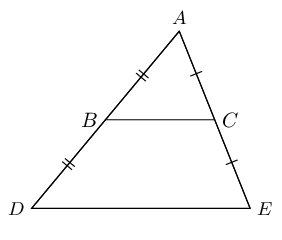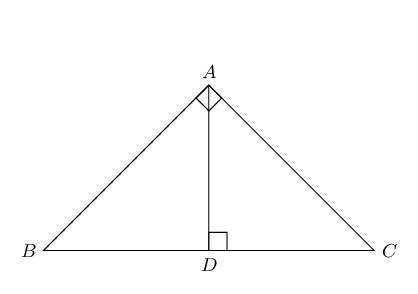8.7 Summary
|
Previous
8.6 Pythagorean theorem
|
Next
End of chapter exercises
|
8.7 Summary (EMCJJ)
-
A ratio describes the relationship between two quantities which have the same units.
x:y or xy or x to y -
If two or more ratios are equal to each other (mn=pq), then m and n are in the same proportion as p and q.
-
A polygon is a plane, closed shape consisting of three or more line segments.
-
Triangles with equal heights have areas which are proportional to their bases.
-
Triangles with equal bases and between the same parallel lines are equal in area.
-
Triangles on the same side of the same base and equal in area lie between parallel lines.
-
A line drawn parallel to one side of a triangle divides the other two sides of the triangle in the same proportion.

-
Converse: proportion theorem
If a line divides two sides of a triangle in the same proportion, then the line is parallel to the third side.
-
Special case: the mid-point theorem
The line joining the mid-points of two sides of a triangle is parallel to the third side and equal to half the length of the third side.
If AB=BD and AC=CE, then BC∥DE and BC=12DE.

-
Converse: the mid-point theorem
The line drawn from the mid-point of one side of a triangle parallel to another side, bisects the third side of the triangle.
If AB=BD and BC∥DE, then AC=CE.
-
Polygons are similar if they are the same shape but differ in size. One polygon is an enlargement of the other.
-
Two polygons with the same number of sides are similar when:
- All pairs of corresponding angles are equal, and
- All pairs of corresponding sides are in the same proportion.
-
If two triangles are equiangular, then the triangles similar.

-
Triangles with sides in proportion are equiangular and therefore similar.

-
The square on the hypotenuse of a right-angled triangle is equal to the sum of the squares on the other two sides.

-
Converse: theorem of Pythagoras
If the square of one side of a triangle is equal to the sum of the squares of the other two sides of the triangle, then the angle included by these two sides is a right angle.
|
Previous
8.6 Pythagorean theorem
|
Table of Contents |
Next
End of chapter exercises
|
